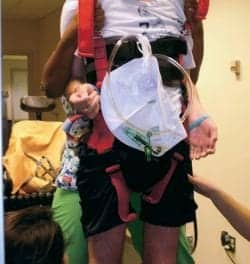The Rehabilitation Institute of Chicago (RIC), is now offering Pediatric Lokomat therapy, or robot-assisted walking therapy, for children with neurological conditions such as cerebral palsy(CP), to help improve their ability to walk and achieve their life goals and dreams, according to RIC.
Cerebral palsy is a neurological condition affecting the motor control portion of the brain often accompanied by secondary orthopaedic conditions affecting a child’s voluntary muscle activation, tone, reflexes, coordination, balance, and ability to walk and be independent. CP is the leading cause of disability in children, and approximately 800,000 adults and children in the United States currently live with CP. An additional 10,000 babies born this year are estimated to develop this condition, according to RICs citation of 2008 data from the Centers for Disease Control (CDC).
"RIC is committed to discovering new treatments that maximize the abilities of kids with cerebral palsy allowing them to achieve their goals in life," says Deborah Gaebler-Spira, MD, director of the cerebral palsy program at RIC. "There is an immense need for research in this area, and RIC is dedicated to examining the vast opportunities and discovering new treatments that advance ability for those who are living with CP."
RIC says that robot-assisted walking therapy is a form of physical therapy that uses a robotic device to help a person improve his or her ability to walk. The patient is suspended in a harness over a treadmill, and an exoskeleton robotic frame, attached by straps to the outside of the legs, moves the legs in a natural walking pattern. A computer controls the pace of walking and measures the body’s response to the movement. The pediatric model also has an interactive gaming interface which, through cartoon characters and challenges, motivates children and provides them instruction.
Currently, this type of physical therapy is conducted with the aid of two or more therapists who manually move the patient’s legs in a walking pattern, according to RIC. The strenuous nature and variability of the manual method can limit the frequency and duration of therapy. In the Lokomat, the robotic device does most of the heavy work, the pattern and pace are consistent throughout the session, and the exercise can be sustained over longer periods of time, making it more effective, according to RIC.
RIC has been examining and tracking the effects of this therapy for adults for years and continues to focus on new research and clinical trials that provide more data on this treatment, according to the Institute. RIC says that it was the first hospital in the United States. to obtain the technology and began clinical trials with the Lokomat when it was first approved by the FDA in March 2002. In addition to its research studies, RIC says it now makes robot-assisted walking therapy available in the clinical setting for adult inpatients and outpatients as well.
In an early study conducted in Europe examining the use of Lokomat therapy for children with CP, results indicated an improvement in walking speed and in gross-motor function, according to RIC (citing The Rehabilitation Centre for Children and Young People (Affoltern am Albis , Switzerland ); Dr von Haunerschen Kinderspital (Munich ) and Hocoma, 2007). The therapy was also rated excellent in providing motivation for carrying out therapy among a majority of children, while there was also a very high level of approval from the therapy team and parents, RIC says.
Children with neurological conditions who are about 4 years old or older (or who have a femur length of at least 21 cm) and who are evaluated by a physician to determine if they are medically appropriate for robot-assisted walking therapy are eligible, says RIC. Those who are interested in having a child evaluated for Lokomat therapy, may call (312) 238-6100 or make an appointment online for an evaluation with Deborah Gaebler-Spira, MD, or Gadi Revivo, DO..
[Source: RIC]




